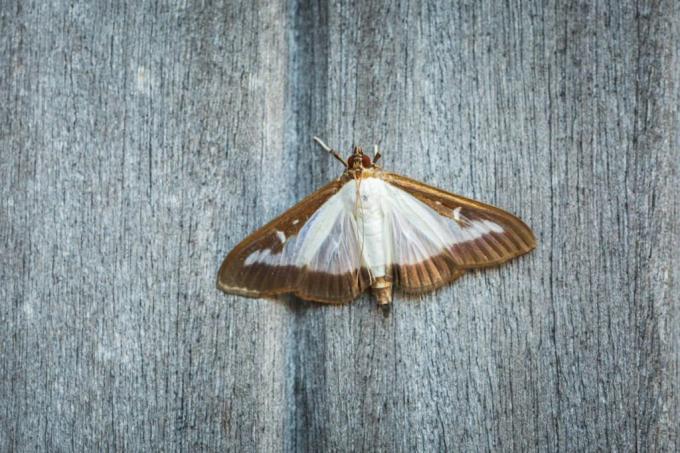Traps for box tree moths are booming in affected regions. Here you can find out whether the pheromone traps are actually effective against the borer and what benefits they have.

who one box hedge (boxy) calls his own, sooner or later he will box tree moth (Cydalima perspectalis) come across - whether in your own garden, in an advertisement in a hardware store or in horror stories from other boxwood owners. Because the hungry pest is spreading – its distribution area is growing across Germany. Southern regions in particular are affected. Before you succumb to the sometimes brazen advertising in the hardware store and look forward to a carefree summer, you will find the necessary facts about box tree moth traps here.
We will inform you in detail about the functionality and effectiveness of pheromone traps for box tree moths. We also show the great benefit of these traps, even if they cannot be used to control moths.
contents
- How do box tree moth traps work?
- Are box tree moth traps effective?
- Moth trap to detect the cycles
- Conclusion: box tree moth trap
How do box tree moth traps work?
Traps for box tree moths work without insecticides and are not used to control moths. Instead, they use very specific sex pheromones that are only perceived by male boxwood moths. They trigger a reaction in these: the male suspects a female ready to mate behind the chemical code of the scent and goes in search of the source of the attractant. When the moth arrives at the trap that emits the attractive odor, it follows the trail to a sticky one glue board or in a drogue under which a water trap is waiting. In any case, the little animal is bound and sooner or later dies. In this way, the presence of the pest can be reliably verified.

Tip to make waterfalls more effective: If a box tree moth trap with a water trap is used, a drop of washing-up liquid in the collection container can improve the success of the catch. If the moth hits the water, it sinks much faster because of the reduced surface tension.
Are box tree moth traps effective?
Because it corresponds to the biology of the box tree moth that only the females send out attractants to attract the males, only traps to catch the males are possible. How well the moths are attracted depends on both the positioning and the mixture of attractants in the respective trap. At our Plantura borer trap is a water trap that covers an area of up to 180 square meters. It is also extremely robust and therefore reusable and does not require any insecticides. Our moth trap comes with 6 attractant dispensers that you should replace every 4 to 6 weeks.
In no case will all flying males end up in the set up trap, but that is not the aim of a box tree moth trap. It is not intended to prevent fertilization and thus egg laying by the female, but rather to prevent it at an early stage Recognize the appearance of nocturnal animals in order to predict imminent egg laying and caterpillar development be able.
Moth trap to detect the cycles
Because the moths are nocturnal and the caterpillars are difficult to track down due to their coloration and position in the boxwood, knowing when the moths fly is of great use to you. This way you know when the search for the caterpillars makes sense and you can quickly take countermeasures after discovering the caterpillars. The development of the moths depends on the weather, but it goes something like this: The adults, that is moths capable of mating develop from overwintered caterpillars around the beginning of June, then quickly complete the mating and die again. The laid eggs develop into the first large caterpillar generation of the year in July, pupate and also become moths in August. These mate, lay eggs, and the resulting caterpillars hibernate again—until next April, when the cycle begins again.

Notice: The development phases of the moth can vary slightly from year to year. Depending on the temperature, three generations per year are possible in southern Germany, which makes close observation all the more important.
Looking at the biology of the moth borer, it becomes clear that the use of sprays or some other form of control at least two times in the year makes sense - namely when the caterpillars are active on the box tree and are also damaged by the agent be able. However, up to four cycles per year are possible, so that monitoring with the help of a trap should take place between March and October in order to ensure reliable moth monitoring guarantee. More to right time of the moth control find out in this article.
Conclusion: box tree moth trap
The developmental stages of the moths can shift, but with their own trap, like that Plantura borer trap, you always know exactly when to expect an infestation with the voracious caterpillars. Combating the moth with a trap is, however, not possible under any circumstances. The trap only shows you when it is the right time to fight the moths. However, this is the necessary prerequisite for effective and targeted control of the voracious caterpillars, because the caterpillars hatch about one to two weeks after the moths have been sighted. Then you should act as soon as possible to prevent defoliation. To combat it, use a biological spray like ours Plantura Zünslerfrei XenTari® best for.
For more information on biological control of the box tree moth we recommend you this article. For a further overview Measures to control the box tree moth you can find a general summary here.



